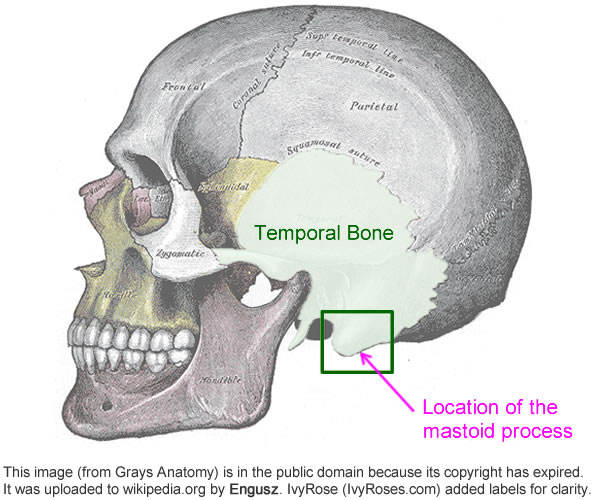
Mastoid process
The mastoid process is a feature on (that is, a distinctive part of) the mastoid portion of the temporal bone.
Where are the temporal bones ?
There are two temporal bones in a normal complete adult skeleton. They are situated on each side of the (right- and left-) sides of the skull, below the parietal bones and above and behind the ears.
Where on the temporal bones are the mastoid processes located, and what do they look like ?
As stated on the page about markings and features on bones, a 'process' on a bone is a "raised area or projection". The mastoid process is a conical prominence projecting from the undersurface of the mastoid portion of the temporal bone, as described more fully below. Note that it is only possible to see this feature when looking at the bone - not when looking at the outside of the complete head while it is still covered with skin and, typically, head hair.
The word 'mastoid' as used to refer to the mastoid process on the temporal bone, comes from the Greek work for 'breast', chosen because the mastoid process was thought to resemble the shape of a nipple or teat.
The mastoid process is the continuation - towards the end of the 'nipple-like prominence' of a slightly larger part of the temporal bone called the *mastoid portion, or sometimes simply the 'mastoid part' of the temporal bone. The whole of the mastoid portion is located at the back (posterior) part of the temporal bone and has a rough outer-surface. Each mastoid portion is perforated by many foramina (pl., sing form = foramen). In general foramina are approx. round holes through which blood vessels, nerves are ligaments pass through the bone. The largest foramen through the mastoid portion is the mastoid foramen which transmits both a vein to the lateral sinus and a small artery from the occipital to supply the dura mater. However the exact size and position of the mastoid foramen varies and is sometimes not present. The mastoid process itself, that is the continuation of the mastoid portion, is also of various relative shapes and sizes.


Functions (uses) of the mastoid processes
These processes serve as points of attachment for muscles, including the:
- sternocleidomastoid (neck muscle)
- splenius capitis (deep neck muscle)
- longissimus capitis (formerly known as the trachelomastoid or the *trachelo-mastoid muscle, this is one of the erector spinae muscles)
Each mastoid process has several grooves or 'fossae' (pl., sing form = fossa). They include the:
- digastric fossa, a deep groove for the attachment of the digastric muscle
- occipital groove, (internal to the digastric fossa) protects the occipital artery
- fossa sigmoidea, encloses part of the lateral sinus
A section of each mastoid process which is separated from the groove for the lateral sinus by only a thin lamina of bone, is hollowed into spaces that form the 'mastoid air cells', which vary considerably in size and quantity. At the upper and front ('anterior') part of the mastoid process the mastoid cells are larger, irregular and contain 'air' (actually a form of skeletal pneumaticity), while further into the lower part of the mastoid process their size is smaller until at the apex of the mastoid process the mastoid cells are only very small and contain bone marrow. In some cases there are no mastoid cells, this part of the mastoid process being solid. In common with other sinuses of the human cranium, the mastoid is not pneumatized at birth. It develops during the first year of life when the it becomes aerated, although the mastoid cells are not fully developed until after puberty.
More about Bones and the Skeletal System:
This website includes many pages about bones and the skeletal system. The following pages may be of interest. These also link to further pages about related topics such as specific types of fractures, bone diseases and so on.
- Structures and Functions of Bones (an overview about the Skeletal System)
- Types of Bones, such as long bones, short bones, flat bones, etc.
- Bone Markings and Features on Bones of the Human Body
- Types of Joints, such as immoveable, slightly moveable and freely moveable joints
- Diagram of the Human Skeleton
- Overview of types of Conditions and Disorders of the Skeletal System
For further information see also our pages of books about orthopaedics.










